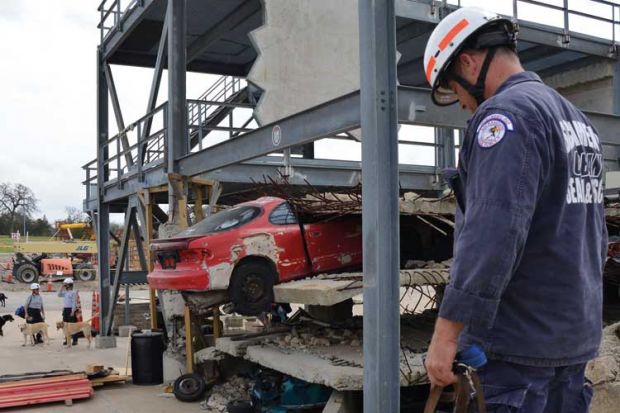The little village just south of the Texas A&M University campus in College Station, Texas, is the unluckiest-looking place on earth.
There are buildings pancaked into rubble by earthquakes and tornadoes, derailed trains, collapsed tunnels, chemical spills, floods, scenes of mass shootings, industrial fires and pandemics.
All this chaos is carefully controlled, however. It is part of a training ground for the people who respond to the world’s growing number and variety of catastrophes. And it is one of the few connected with a university, allowing for not only training in how to handle these events but also research that can help to prevent them.
“The thing that really separates this place is that association with higher education,” said David Martin, director of rescue training and the de facto mayor of Disaster City, as the facility – formally called the Emergency Services Training Institute – has been more colourfully nicknamed. “So we have a very close relationship with people who are not only doing things like research into the use of robotics and other kinds of technology that can assist in search and rescue, but who can also look at why buildings collapse and how we can make them safer.”
Many universities and others are getting into this sort of training, thanks to the large amounts of government money available to pay for it. The US alone spends nearly $70 billion (£46 billion) a year on domestic disaster relief, according to the Center for American Progress, and separately pays for training for more than 2.5 million state and local emergency workers, budget reports from the Federal Emergency Management Agency show.
But Disaster City’s connection with Texas A&M puts it in a unique position. It produces the courses used by other providers’ programmes and when a network of 28 urban search-and-rescue teams was created nationwide, it claimed to have the only one connected with a university; the others are attached to major municipal fire departments.
The benefits work both ways, Mr Martin said. Academics, including engineers, “get a unique facility where they can come and do some real-world testing. But they also don’t have real-world experience responding to these disasters, so they appreciate having the first responders we bring in, who can talk to them about what they do.”
Those conversations result in practical improvements to emergency-response technology.
On the other hand, said Mr Martin, “if I need an expert or an engineer to tell me how much force a particular shoring brace can take, they can not only tell me, they can also put it into a machine to show me at what point it fails”.
Training in teamwork
When a professor at the university’s medical school learned of a Disaster City programme that brings together paramedics who attend the scene of an emergency with hospital doctors, he asked why medical students were not learning this sort of teamwork, too. The result: fourth-year medical students from Texas A&M’s Health Science Center now spend a week on the programme being trained as disaster medical responders.
But the most eye-catching part of Disaster City, which is now undergoing a $1.2 million expansion, is undeniably all of that concocted pandemonium in the recreated town beside the campus, which includes an actual derailed train salvaged from an accident.
“The Disney World of first responders,” Mr Martin calls it.
About 500 emergency workers from the UK underwent training at the site starting in 2003, among the 81,000 trainees per year from all 50 US states and 45 countries who have gone through the programme. Many were on hand to react to the terrorist attacks on London’s transport system in 2005.
There are also facilities to prepare responses to cyber attacks, one of the newest threats to public security, along with pandemics.
Other projects include Disaster City helping engineers to develop a four-wheel, amphibious multipurpose unmanned tactical transport robot, or Mutt, which can carry a victim on a stretcher and follow rescuers wherever they go.
Researchers are also testing a smaller robot called Marsupial, to be attached to search-and-rescue dogs, which, when a victim is detected under rubble, can detach and search the person out with microphones and cameras.
This entire discipline dates from 1989, when an earthquake in San Francisco made clear the need for training urban emergency workers. That has accelerated with the rise of terrorism, the encroachment of people into storm- and flood-prone areas and the increased ease of transportation that has sped up the spread of disease.
“Anyone who’s an emergency responder who tells you they don’t sit there and daydream and imagine the worst-case scenario and how would I best respond to you is either a liar or he’s in the wrong business. That is what we do,” said Mr Martin.
There is one other advantage in Disaster City’s link to Texas A&M: “We have absolutely no trouble getting live victims” from among students, Mr Martin said, with volunteers even competing for an “Academy Award” for the best portrayal of an injured person.
“They’ll come out here for a pizza and a T-shirt,” Mr Martin said, “and we will hide them in the rubble piles.”
Register to continue
Why register?
- Registration is free and only takes a moment
- Once registered, you can read 3 articles a month
- Sign up for our newsletter
Subscribe
Or subscribe for unlimited access to:
- Unlimited access to news, views, insights & reviews
- Digital editions
- Digital access to THE’s university and college rankings analysis
Already registered or a current subscriber? Login





